Management and Business Context: Foodmart Restaurant, KM & E-commerce
VerifiedAdded on 2019/11/19
|9
|2447
|178
Essay
AI Summary
This essay provides an analysis of the impact of knowledge management (KM) and e-commerce on the business performance of Foodmart Restaurant. It begins by introducing the significance of KM and internet technology in the current business scenario, highlighting how KM offers sustainable advantages and how e-commerce enables direct customer communication. The essay delves into the concepts of KM, emphasizing its role in acquiring, distributing, and utilizing knowledge, fostering innovation, and enhancing customer satisfaction. It explores how KM facilitates rapid action, improves product and service features, and helps Foodmart Restaurant gain a competitive edge in the Australian restaurant industry. The essay also examines the role of e-commerce, illustrating how it reduces expenses, enhances service delivery, and enables the sharing of information through various electronic channels. It discusses the benefits of e-commerce for both customers and the business, including wider product availability and online payment options. The essay concludes by summarizing the importance of both KM and e-commerce in improving Foodmart Restaurant's business practices and performance, emphasizing their combined impact on efficiency, customer satisfaction, and competitive advantage. The essay references multiple academic sources to support its arguments.
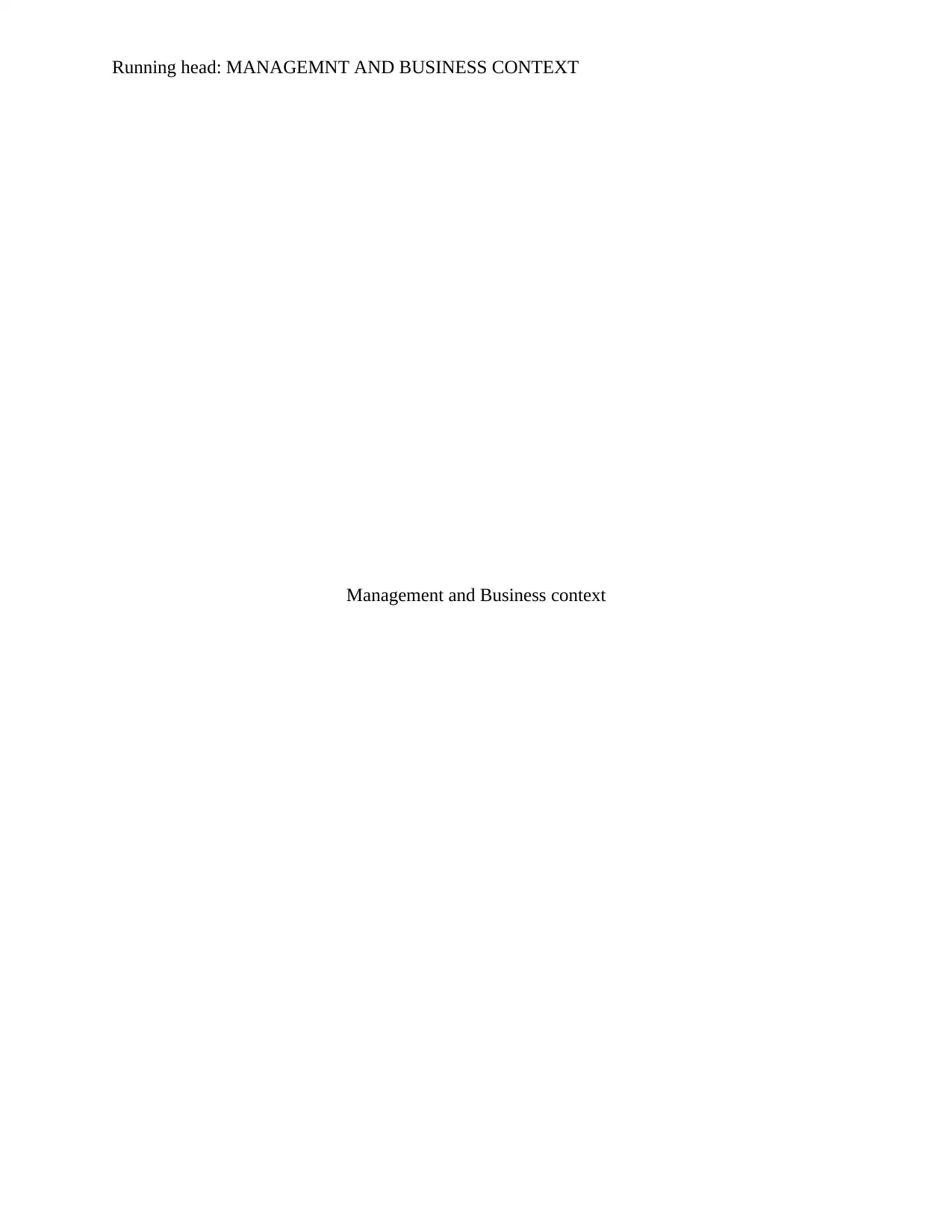
Running head: MANAGEMNT AND BUSINESS CONTEXT
Management and Business context
Management and Business context
Paraphrase This Document
Need a fresh take? Get an instant paraphrase of this document with our AI Paraphraser
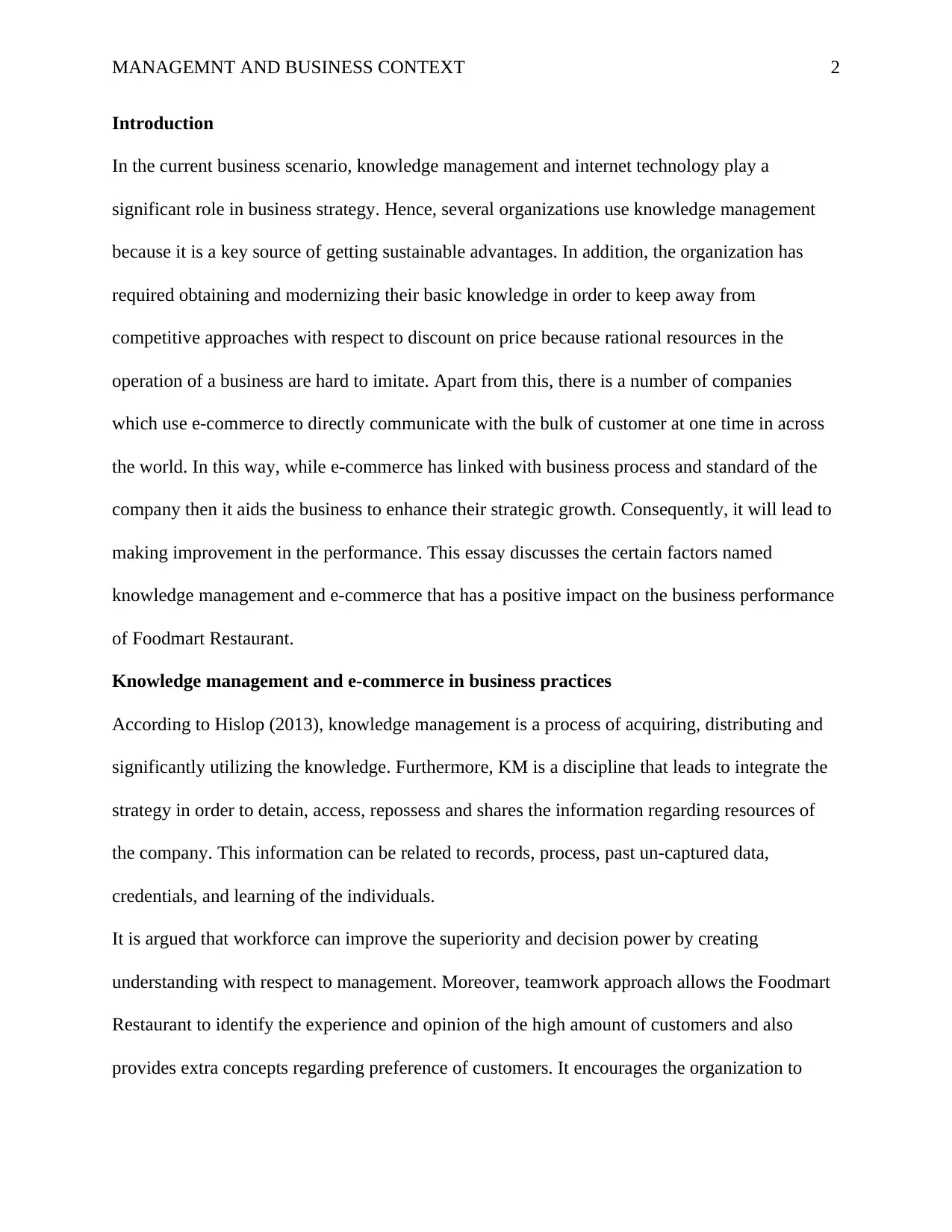
MANAGEMNT AND BUSINESS CONTEXT 2
Introduction
In the current business scenario, knowledge management and internet technology play a
significant role in business strategy. Hence, several organizations use knowledge management
because it is a key source of getting sustainable advantages. In addition, the organization has
required obtaining and modernizing their basic knowledge in order to keep away from
competitive approaches with respect to discount on price because rational resources in the
operation of a business are hard to imitate. Apart from this, there is a number of companies
which use e-commerce to directly communicate with the bulk of customer at one time in across
the world. In this way, while e-commerce has linked with business process and standard of the
company then it aids the business to enhance their strategic growth. Consequently, it will lead to
making improvement in the performance. This essay discusses the certain factors named
knowledge management and e-commerce that has a positive impact on the business performance
of Foodmart Restaurant.
Knowledge management and e-commerce in business practices
According to Hislop (2013), knowledge management is a process of acquiring, distributing and
significantly utilizing the knowledge. Furthermore, KM is a discipline that leads to integrate the
strategy in order to detain, access, repossess and shares the information regarding resources of
the company. This information can be related to records, process, past un-captured data,
credentials, and learning of the individuals.
It is argued that workforce can improve the superiority and decision power by creating
understanding with respect to management. Moreover, teamwork approach allows the Foodmart
Restaurant to identify the experience and opinion of the high amount of customers and also
provides extra concepts regarding preference of customers. It encourages the organization to
Introduction
In the current business scenario, knowledge management and internet technology play a
significant role in business strategy. Hence, several organizations use knowledge management
because it is a key source of getting sustainable advantages. In addition, the organization has
required obtaining and modernizing their basic knowledge in order to keep away from
competitive approaches with respect to discount on price because rational resources in the
operation of a business are hard to imitate. Apart from this, there is a number of companies
which use e-commerce to directly communicate with the bulk of customer at one time in across
the world. In this way, while e-commerce has linked with business process and standard of the
company then it aids the business to enhance their strategic growth. Consequently, it will lead to
making improvement in the performance. This essay discusses the certain factors named
knowledge management and e-commerce that has a positive impact on the business performance
of Foodmart Restaurant.
Knowledge management and e-commerce in business practices
According to Hislop (2013), knowledge management is a process of acquiring, distributing and
significantly utilizing the knowledge. Furthermore, KM is a discipline that leads to integrate the
strategy in order to detain, access, repossess and shares the information regarding resources of
the company. This information can be related to records, process, past un-captured data,
credentials, and learning of the individuals.
It is argued that workforce can improve the superiority and decision power by creating
understanding with respect to management. Moreover, teamwork approach allows the Foodmart
Restaurant to identify the experience and opinion of the high amount of customers and also
provides extra concepts regarding preference of customers. It encourages the organization to
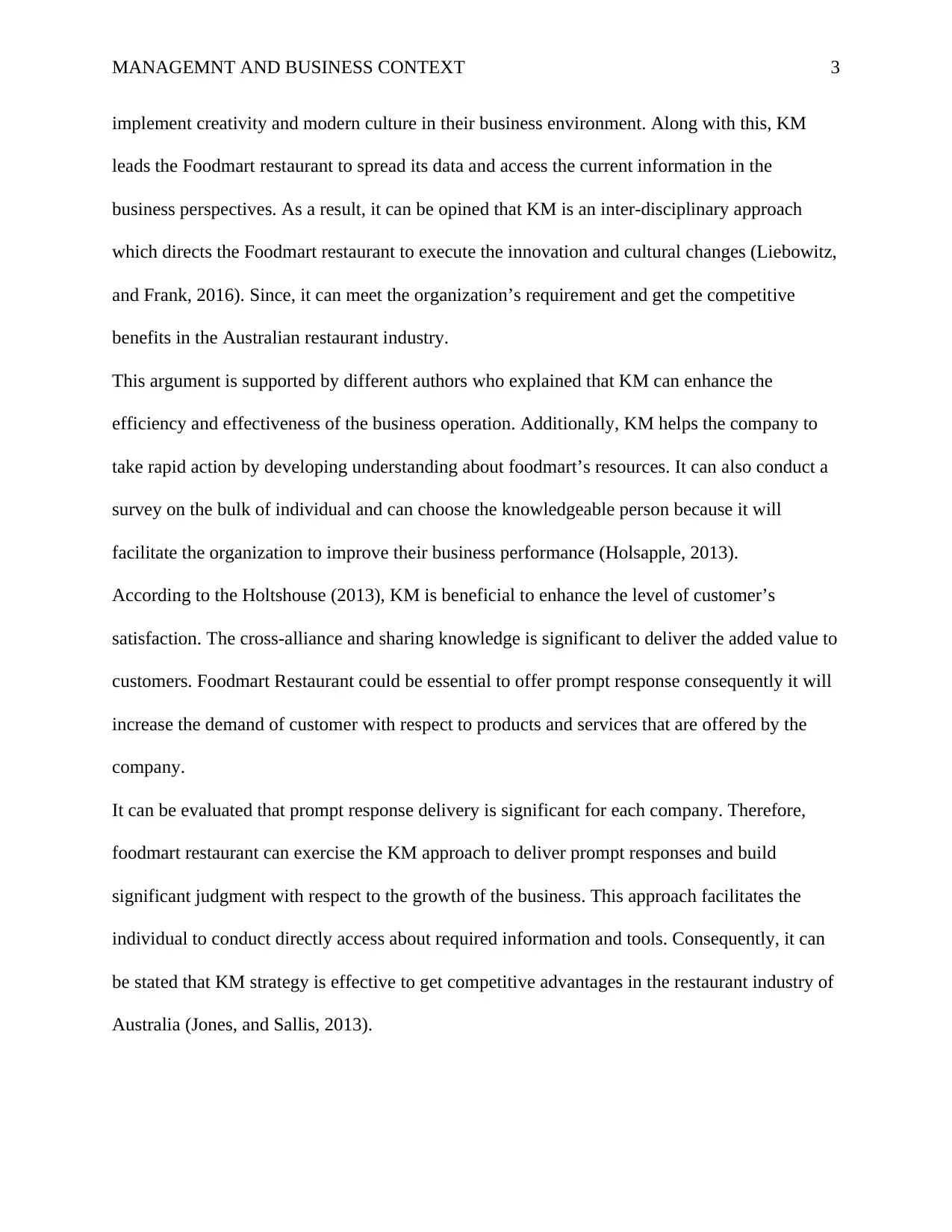
MANAGEMNT AND BUSINESS CONTEXT 3
implement creativity and modern culture in their business environment. Along with this, KM
leads the Foodmart restaurant to spread its data and access the current information in the
business perspectives. As a result, it can be opined that KM is an inter-disciplinary approach
which directs the Foodmart restaurant to execute the innovation and cultural changes (Liebowitz,
and Frank, 2016). Since, it can meet the organization’s requirement and get the competitive
benefits in the Australian restaurant industry.
This argument is supported by different authors who explained that KM can enhance the
efficiency and effectiveness of the business operation. Additionally, KM helps the company to
take rapid action by developing understanding about foodmart’s resources. It can also conduct a
survey on the bulk of individual and can choose the knowledgeable person because it will
facilitate the organization to improve their business performance (Holsapple, 2013).
According to the Holtshouse (2013), KM is beneficial to enhance the level of customer’s
satisfaction. The cross-alliance and sharing knowledge is significant to deliver the added value to
customers. Foodmart Restaurant could be essential to offer prompt response consequently it will
increase the demand of customer with respect to products and services that are offered by the
company.
It can be evaluated that prompt response delivery is significant for each company. Therefore,
foodmart restaurant can exercise the KM approach to deliver prompt responses and build
significant judgment with respect to the growth of the business. This approach facilitates the
individual to conduct directly access about required information and tools. Consequently, it can
be stated that KM strategy is effective to get competitive advantages in the restaurant industry of
Australia (Jones, and Sallis, 2013).
implement creativity and modern culture in their business environment. Along with this, KM
leads the Foodmart restaurant to spread its data and access the current information in the
business perspectives. As a result, it can be opined that KM is an inter-disciplinary approach
which directs the Foodmart restaurant to execute the innovation and cultural changes (Liebowitz,
and Frank, 2016). Since, it can meet the organization’s requirement and get the competitive
benefits in the Australian restaurant industry.
This argument is supported by different authors who explained that KM can enhance the
efficiency and effectiveness of the business operation. Additionally, KM helps the company to
take rapid action by developing understanding about foodmart’s resources. It can also conduct a
survey on the bulk of individual and can choose the knowledgeable person because it will
facilitate the organization to improve their business performance (Holsapple, 2013).
According to the Holtshouse (2013), KM is beneficial to enhance the level of customer’s
satisfaction. The cross-alliance and sharing knowledge is significant to deliver the added value to
customers. Foodmart Restaurant could be essential to offer prompt response consequently it will
increase the demand of customer with respect to products and services that are offered by the
company.
It can be evaluated that prompt response delivery is significant for each company. Therefore,
foodmart restaurant can exercise the KM approach to deliver prompt responses and build
significant judgment with respect to the growth of the business. This approach facilitates the
individual to conduct directly access about required information and tools. Consequently, it can
be stated that KM strategy is effective to get competitive advantages in the restaurant industry of
Australia (Jones, and Sallis, 2013).
⊘ This is a preview!⊘
Do you want full access?
Subscribe today to unlock all pages.

Trusted by 1+ million students worldwide
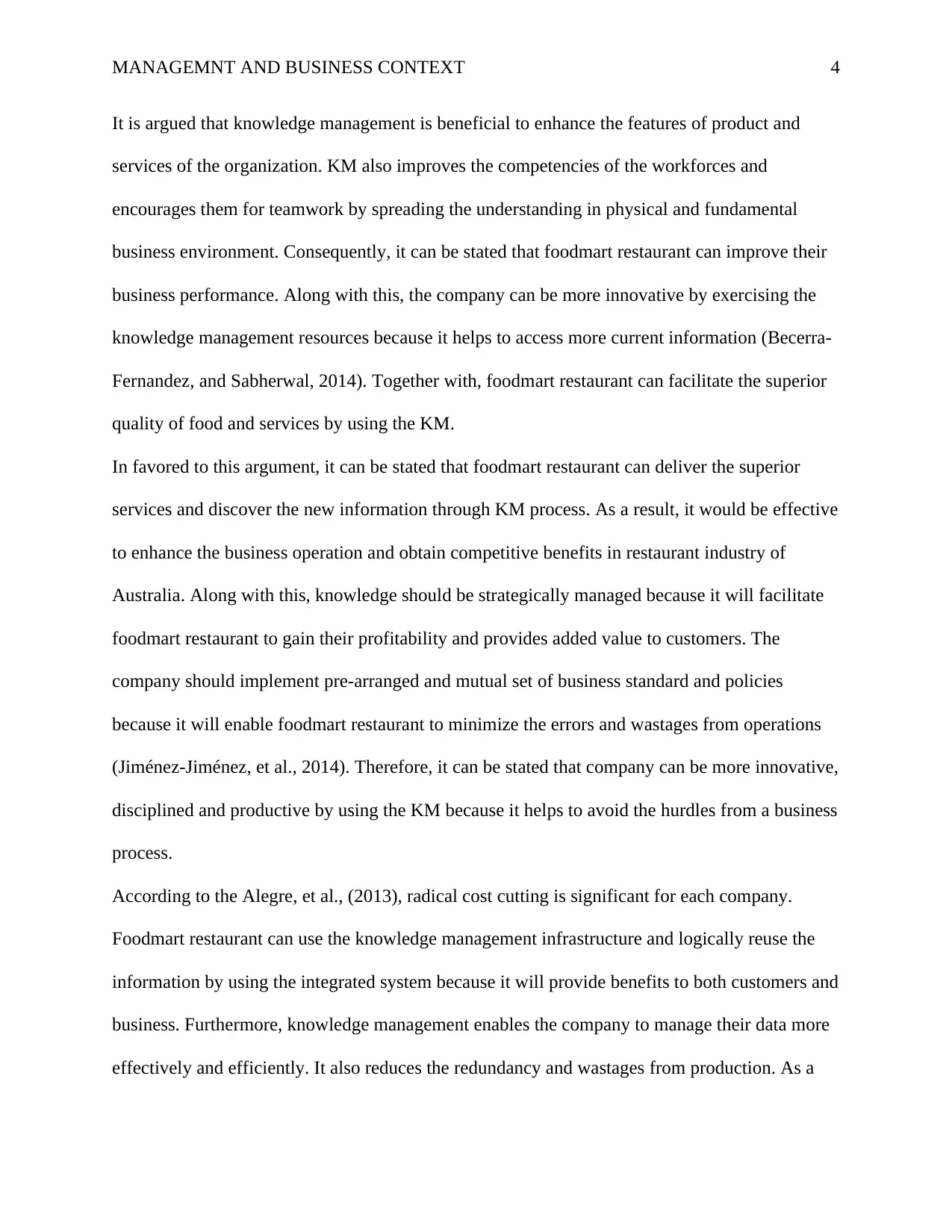
MANAGEMNT AND BUSINESS CONTEXT 4
It is argued that knowledge management is beneficial to enhance the features of product and
services of the organization. KM also improves the competencies of the workforces and
encourages them for teamwork by spreading the understanding in physical and fundamental
business environment. Consequently, it can be stated that foodmart restaurant can improve their
business performance. Along with this, the company can be more innovative by exercising the
knowledge management resources because it helps to access more current information (Becerra-
Fernandez, and Sabherwal, 2014). Together with, foodmart restaurant can facilitate the superior
quality of food and services by using the KM.
In favored to this argument, it can be stated that foodmart restaurant can deliver the superior
services and discover the new information through KM process. As a result, it would be effective
to enhance the business operation and obtain competitive benefits in restaurant industry of
Australia. Along with this, knowledge should be strategically managed because it will facilitate
foodmart restaurant to gain their profitability and provides added value to customers. The
company should implement pre-arranged and mutual set of business standard and policies
because it will enable foodmart restaurant to minimize the errors and wastages from operations
(Jiménez-Jiménez, et al., 2014). Therefore, it can be stated that company can be more innovative,
disciplined and productive by using the KM because it helps to avoid the hurdles from a business
process.
According to the Alegre, et al., (2013), radical cost cutting is significant for each company.
Foodmart restaurant can use the knowledge management infrastructure and logically reuse the
information by using the integrated system because it will provide benefits to both customers and
business. Furthermore, knowledge management enables the company to manage their data more
effectively and efficiently. It also reduces the redundancy and wastages from production. As a
It is argued that knowledge management is beneficial to enhance the features of product and
services of the organization. KM also improves the competencies of the workforces and
encourages them for teamwork by spreading the understanding in physical and fundamental
business environment. Consequently, it can be stated that foodmart restaurant can improve their
business performance. Along with this, the company can be more innovative by exercising the
knowledge management resources because it helps to access more current information (Becerra-
Fernandez, and Sabherwal, 2014). Together with, foodmart restaurant can facilitate the superior
quality of food and services by using the KM.
In favored to this argument, it can be stated that foodmart restaurant can deliver the superior
services and discover the new information through KM process. As a result, it would be effective
to enhance the business operation and obtain competitive benefits in restaurant industry of
Australia. Along with this, knowledge should be strategically managed because it will facilitate
foodmart restaurant to gain their profitability and provides added value to customers. The
company should implement pre-arranged and mutual set of business standard and policies
because it will enable foodmart restaurant to minimize the errors and wastages from operations
(Jiménez-Jiménez, et al., 2014). Therefore, it can be stated that company can be more innovative,
disciplined and productive by using the KM because it helps to avoid the hurdles from a business
process.
According to the Alegre, et al., (2013), radical cost cutting is significant for each company.
Foodmart restaurant can use the knowledge management infrastructure and logically reuse the
information by using the integrated system because it will provide benefits to both customers and
business. Furthermore, knowledge management enables the company to manage their data more
effectively and efficiently. It also reduces the redundancy and wastages from production. As a
Paraphrase This Document
Need a fresh take? Get an instant paraphrase of this document with our AI Paraphraser
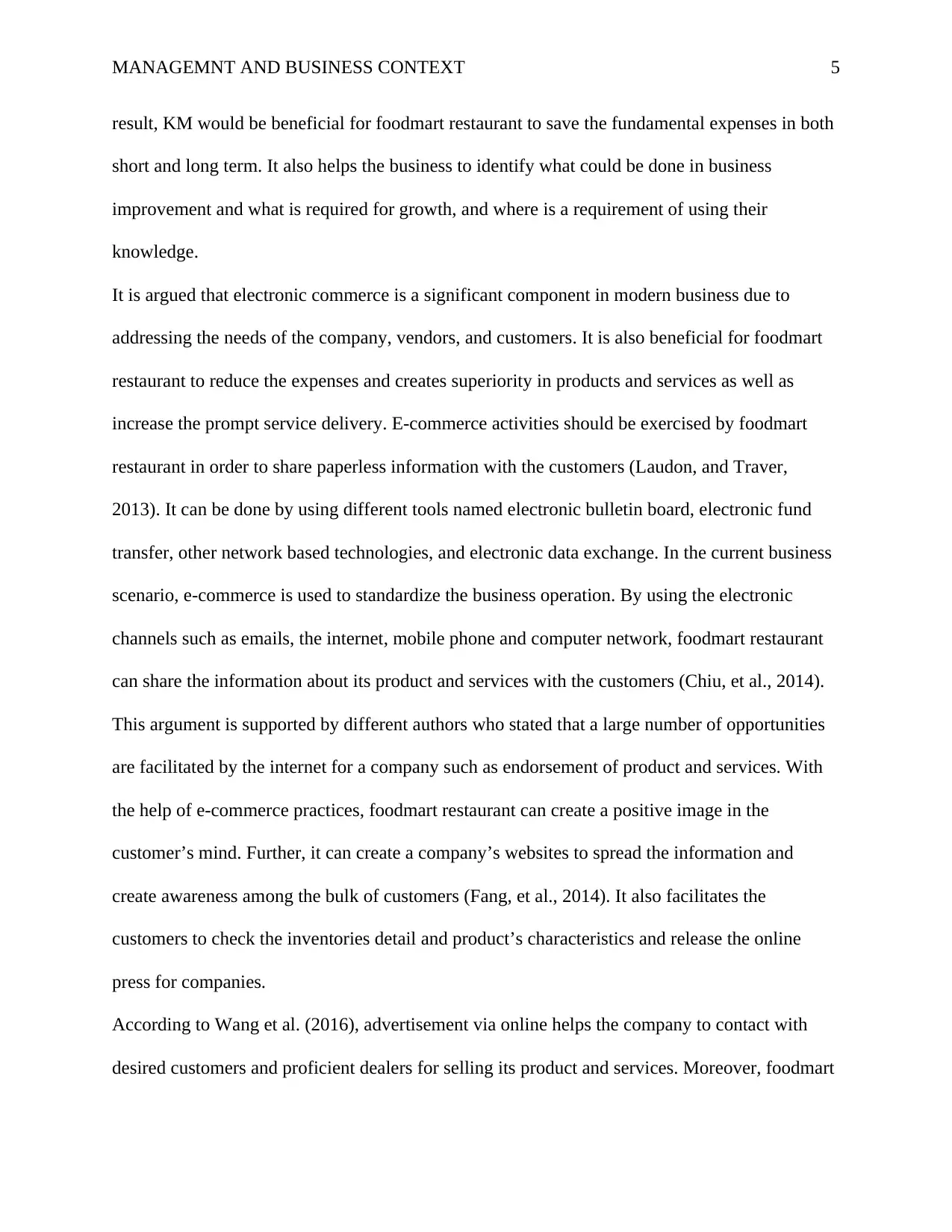
MANAGEMNT AND BUSINESS CONTEXT 5
result, KM would be beneficial for foodmart restaurant to save the fundamental expenses in both
short and long term. It also helps the business to identify what could be done in business
improvement and what is required for growth, and where is a requirement of using their
knowledge.
It is argued that electronic commerce is a significant component in modern business due to
addressing the needs of the company, vendors, and customers. It is also beneficial for foodmart
restaurant to reduce the expenses and creates superiority in products and services as well as
increase the prompt service delivery. E-commerce activities should be exercised by foodmart
restaurant in order to share paperless information with the customers (Laudon, and Traver,
2013). It can be done by using different tools named electronic bulletin board, electronic fund
transfer, other network based technologies, and electronic data exchange. In the current business
scenario, e-commerce is used to standardize the business operation. By using the electronic
channels such as emails, the internet, mobile phone and computer network, foodmart restaurant
can share the information about its product and services with the customers (Chiu, et al., 2014).
This argument is supported by different authors who stated that a large number of opportunities
are facilitated by the internet for a company such as endorsement of product and services. With
the help of e-commerce practices, foodmart restaurant can create a positive image in the
customer’s mind. Further, it can create a company’s websites to spread the information and
create awareness among the bulk of customers (Fang, et al., 2014). It also facilitates the
customers to check the inventories detail and product’s characteristics and release the online
press for companies.
According to Wang et al. (2016), advertisement via online helps the company to contact with
desired customers and proficient dealers for selling its product and services. Moreover, foodmart
result, KM would be beneficial for foodmart restaurant to save the fundamental expenses in both
short and long term. It also helps the business to identify what could be done in business
improvement and what is required for growth, and where is a requirement of using their
knowledge.
It is argued that electronic commerce is a significant component in modern business due to
addressing the needs of the company, vendors, and customers. It is also beneficial for foodmart
restaurant to reduce the expenses and creates superiority in products and services as well as
increase the prompt service delivery. E-commerce activities should be exercised by foodmart
restaurant in order to share paperless information with the customers (Laudon, and Traver,
2013). It can be done by using different tools named electronic bulletin board, electronic fund
transfer, other network based technologies, and electronic data exchange. In the current business
scenario, e-commerce is used to standardize the business operation. By using the electronic
channels such as emails, the internet, mobile phone and computer network, foodmart restaurant
can share the information about its product and services with the customers (Chiu, et al., 2014).
This argument is supported by different authors who stated that a large number of opportunities
are facilitated by the internet for a company such as endorsement of product and services. With
the help of e-commerce practices, foodmart restaurant can create a positive image in the
customer’s mind. Further, it can create a company’s websites to spread the information and
create awareness among the bulk of customers (Fang, et al., 2014). It also facilitates the
customers to check the inventories detail and product’s characteristics and release the online
press for companies.
According to Wang et al. (2016), advertisement via online helps the company to contact with
desired customers and proficient dealers for selling its product and services. Moreover, foodmart
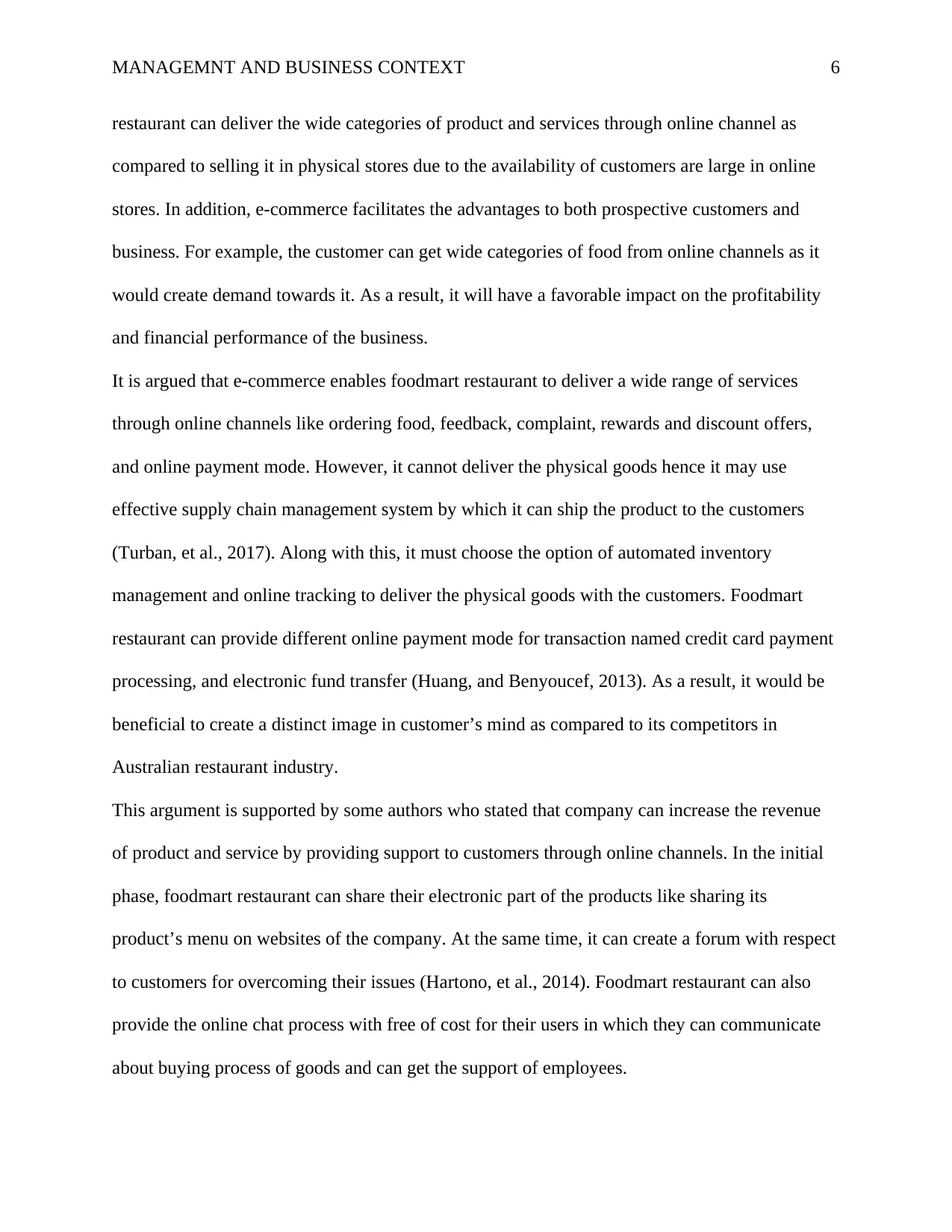
MANAGEMNT AND BUSINESS CONTEXT 6
restaurant can deliver the wide categories of product and services through online channel as
compared to selling it in physical stores due to the availability of customers are large in online
stores. In addition, e-commerce facilitates the advantages to both prospective customers and
business. For example, the customer can get wide categories of food from online channels as it
would create demand towards it. As a result, it will have a favorable impact on the profitability
and financial performance of the business.
It is argued that e-commerce enables foodmart restaurant to deliver a wide range of services
through online channels like ordering food, feedback, complaint, rewards and discount offers,
and online payment mode. However, it cannot deliver the physical goods hence it may use
effective supply chain management system by which it can ship the product to the customers
(Turban, et al., 2017). Along with this, it must choose the option of automated inventory
management and online tracking to deliver the physical goods with the customers. Foodmart
restaurant can provide different online payment mode for transaction named credit card payment
processing, and electronic fund transfer (Huang, and Benyoucef, 2013). As a result, it would be
beneficial to create a distinct image in customer’s mind as compared to its competitors in
Australian restaurant industry.
This argument is supported by some authors who stated that company can increase the revenue
of product and service by providing support to customers through online channels. In the initial
phase, foodmart restaurant can share their electronic part of the products like sharing its
product’s menu on websites of the company. At the same time, it can create a forum with respect
to customers for overcoming their issues (Hartono, et al., 2014). Foodmart restaurant can also
provide the online chat process with free of cost for their users in which they can communicate
about buying process of goods and can get the support of employees.
restaurant can deliver the wide categories of product and services through online channel as
compared to selling it in physical stores due to the availability of customers are large in online
stores. In addition, e-commerce facilitates the advantages to both prospective customers and
business. For example, the customer can get wide categories of food from online channels as it
would create demand towards it. As a result, it will have a favorable impact on the profitability
and financial performance of the business.
It is argued that e-commerce enables foodmart restaurant to deliver a wide range of services
through online channels like ordering food, feedback, complaint, rewards and discount offers,
and online payment mode. However, it cannot deliver the physical goods hence it may use
effective supply chain management system by which it can ship the product to the customers
(Turban, et al., 2017). Along with this, it must choose the option of automated inventory
management and online tracking to deliver the physical goods with the customers. Foodmart
restaurant can provide different online payment mode for transaction named credit card payment
processing, and electronic fund transfer (Huang, and Benyoucef, 2013). As a result, it would be
beneficial to create a distinct image in customer’s mind as compared to its competitors in
Australian restaurant industry.
This argument is supported by some authors who stated that company can increase the revenue
of product and service by providing support to customers through online channels. In the initial
phase, foodmart restaurant can share their electronic part of the products like sharing its
product’s menu on websites of the company. At the same time, it can create a forum with respect
to customers for overcoming their issues (Hartono, et al., 2014). Foodmart restaurant can also
provide the online chat process with free of cost for their users in which they can communicate
about buying process of goods and can get the support of employees.
⊘ This is a preview!⊘
Do you want full access?
Subscribe today to unlock all pages.

Trusted by 1+ million students worldwide
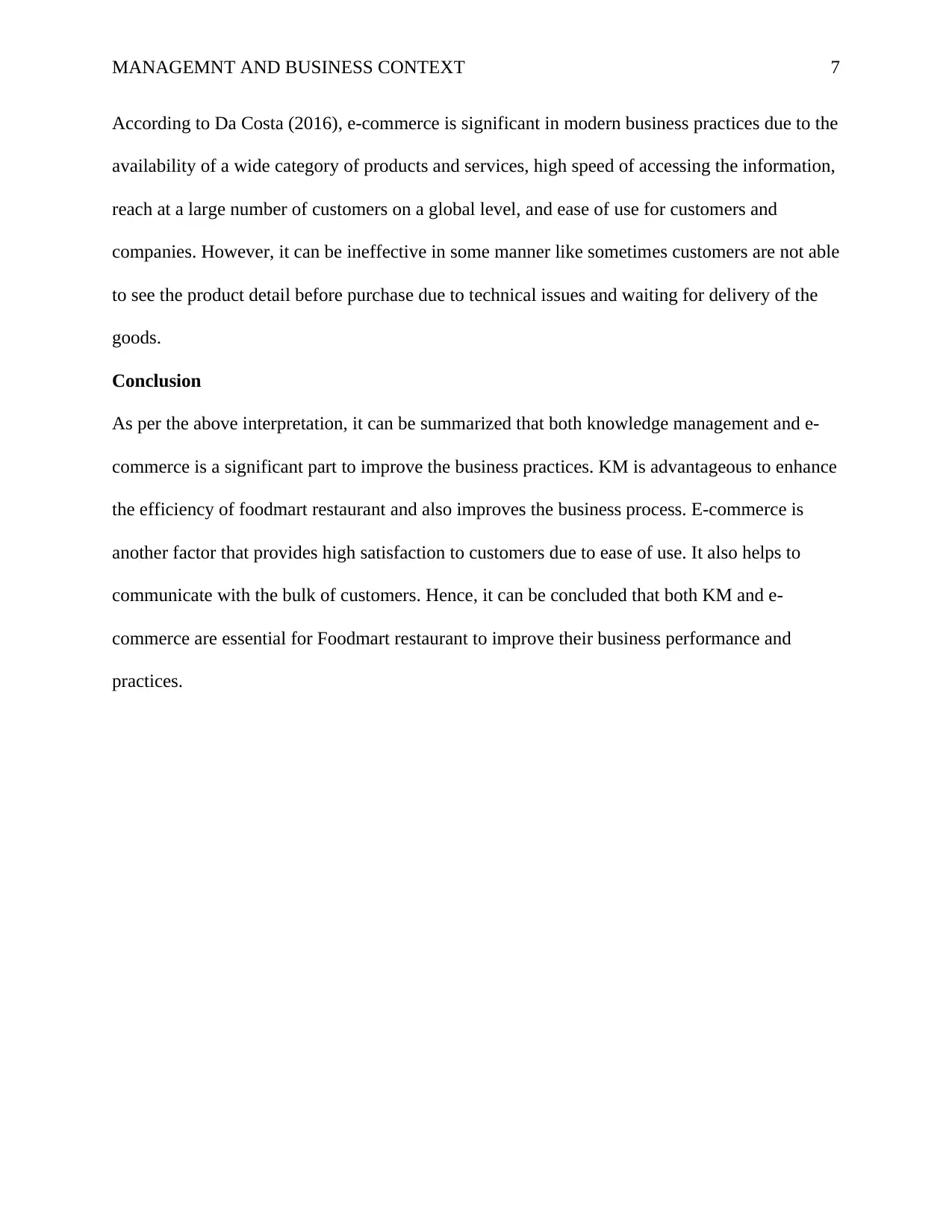
MANAGEMNT AND BUSINESS CONTEXT 7
According to Da Costa (2016), e-commerce is significant in modern business practices due to the
availability of a wide category of products and services, high speed of accessing the information,
reach at a large number of customers on a global level, and ease of use for customers and
companies. However, it can be ineffective in some manner like sometimes customers are not able
to see the product detail before purchase due to technical issues and waiting for delivery of the
goods.
Conclusion
As per the above interpretation, it can be summarized that both knowledge management and e-
commerce is a significant part to improve the business practices. KM is advantageous to enhance
the efficiency of foodmart restaurant and also improves the business process. E-commerce is
another factor that provides high satisfaction to customers due to ease of use. It also helps to
communicate with the bulk of customers. Hence, it can be concluded that both KM and e-
commerce are essential for Foodmart restaurant to improve their business performance and
practices.
According to Da Costa (2016), e-commerce is significant in modern business practices due to the
availability of a wide category of products and services, high speed of accessing the information,
reach at a large number of customers on a global level, and ease of use for customers and
companies. However, it can be ineffective in some manner like sometimes customers are not able
to see the product detail before purchase due to technical issues and waiting for delivery of the
goods.
Conclusion
As per the above interpretation, it can be summarized that both knowledge management and e-
commerce is a significant part to improve the business practices. KM is advantageous to enhance
the efficiency of foodmart restaurant and also improves the business process. E-commerce is
another factor that provides high satisfaction to customers due to ease of use. It also helps to
communicate with the bulk of customers. Hence, it can be concluded that both KM and e-
commerce are essential for Foodmart restaurant to improve their business performance and
practices.
Paraphrase This Document
Need a fresh take? Get an instant paraphrase of this document with our AI Paraphraser
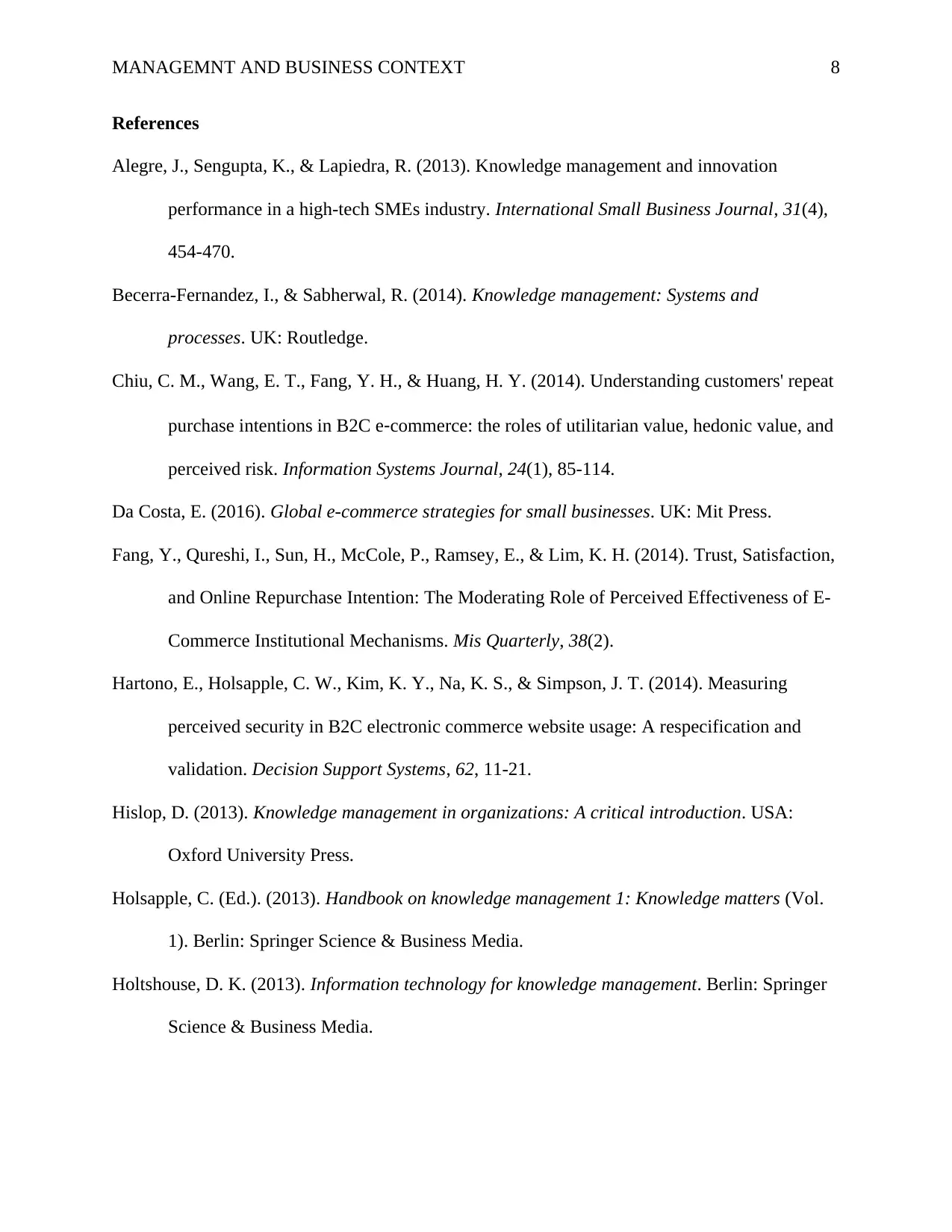
MANAGEMNT AND BUSINESS CONTEXT 8
References
Alegre, J., Sengupta, K., & Lapiedra, R. (2013). Knowledge management and innovation
performance in a high-tech SMEs industry. International Small Business Journal, 31(4),
454-470.
Becerra-Fernandez, I., & Sabherwal, R. (2014). Knowledge management: Systems and
processes. UK: Routledge.
Chiu, C. M., Wang, E. T., Fang, Y. H., & Huang, H. Y. (2014). Understanding customers' repeat
purchase intentions in B2C e‐commerce: the roles of utilitarian value, hedonic value, and
perceived risk. Information Systems Journal, 24(1), 85-114.
Da Costa, E. (2016). Global e-commerce strategies for small businesses. UK: Mit Press.
Fang, Y., Qureshi, I., Sun, H., McCole, P., Ramsey, E., & Lim, K. H. (2014). Trust, Satisfaction,
and Online Repurchase Intention: The Moderating Role of Perceived Effectiveness of E-
Commerce Institutional Mechanisms. Mis Quarterly, 38(2).
Hartono, E., Holsapple, C. W., Kim, K. Y., Na, K. S., & Simpson, J. T. (2014). Measuring
perceived security in B2C electronic commerce website usage: A respecification and
validation. Decision Support Systems, 62, 11-21.
Hislop, D. (2013). Knowledge management in organizations: A critical introduction. USA:
Oxford University Press.
Holsapple, C. (Ed.). (2013). Handbook on knowledge management 1: Knowledge matters (Vol.
1). Berlin: Springer Science & Business Media.
Holtshouse, D. K. (2013). Information technology for knowledge management. Berlin: Springer
Science & Business Media.
References
Alegre, J., Sengupta, K., & Lapiedra, R. (2013). Knowledge management and innovation
performance in a high-tech SMEs industry. International Small Business Journal, 31(4),
454-470.
Becerra-Fernandez, I., & Sabherwal, R. (2014). Knowledge management: Systems and
processes. UK: Routledge.
Chiu, C. M., Wang, E. T., Fang, Y. H., & Huang, H. Y. (2014). Understanding customers' repeat
purchase intentions in B2C e‐commerce: the roles of utilitarian value, hedonic value, and
perceived risk. Information Systems Journal, 24(1), 85-114.
Da Costa, E. (2016). Global e-commerce strategies for small businesses. UK: Mit Press.
Fang, Y., Qureshi, I., Sun, H., McCole, P., Ramsey, E., & Lim, K. H. (2014). Trust, Satisfaction,
and Online Repurchase Intention: The Moderating Role of Perceived Effectiveness of E-
Commerce Institutional Mechanisms. Mis Quarterly, 38(2).
Hartono, E., Holsapple, C. W., Kim, K. Y., Na, K. S., & Simpson, J. T. (2014). Measuring
perceived security in B2C electronic commerce website usage: A respecification and
validation. Decision Support Systems, 62, 11-21.
Hislop, D. (2013). Knowledge management in organizations: A critical introduction. USA:
Oxford University Press.
Holsapple, C. (Ed.). (2013). Handbook on knowledge management 1: Knowledge matters (Vol.
1). Berlin: Springer Science & Business Media.
Holtshouse, D. K. (2013). Information technology for knowledge management. Berlin: Springer
Science & Business Media.
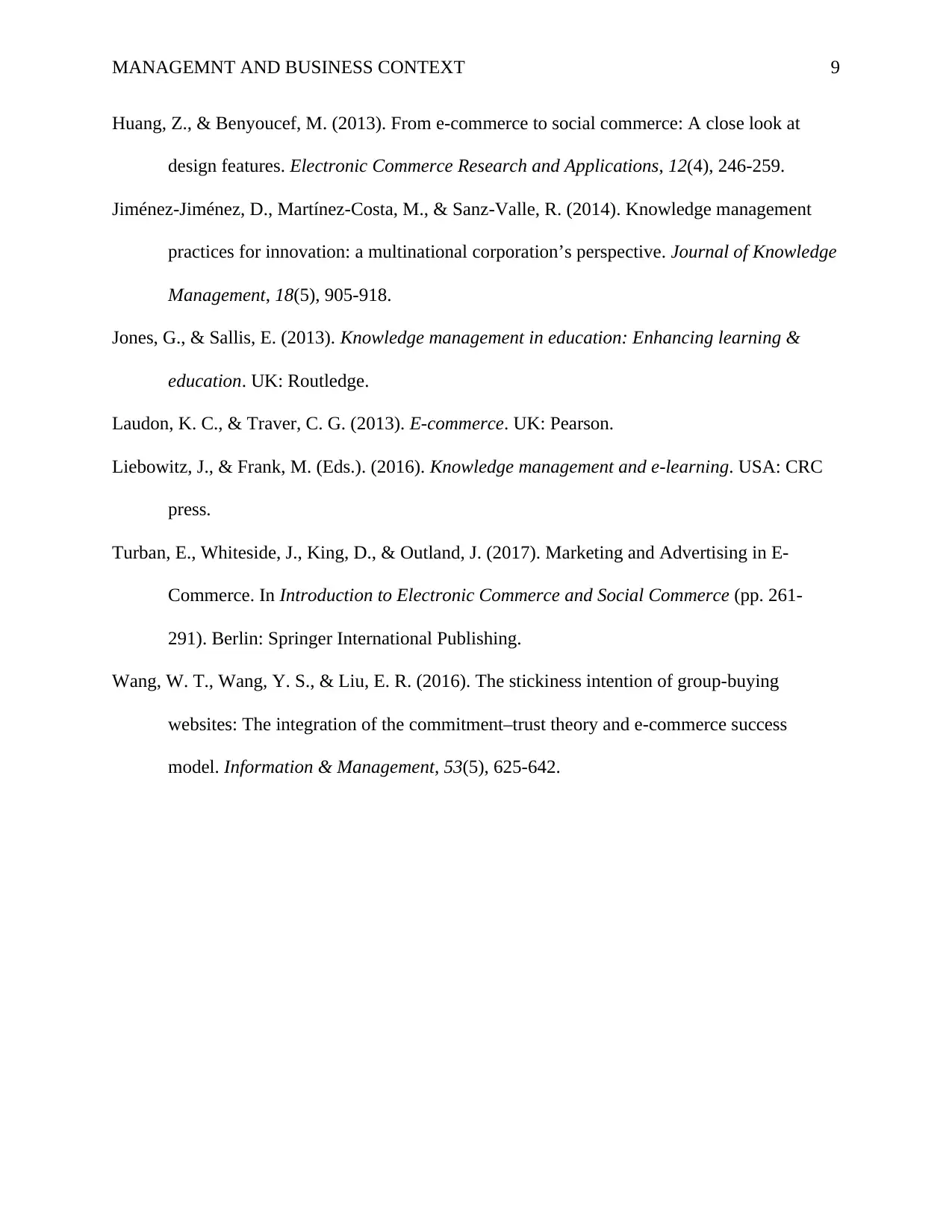
MANAGEMNT AND BUSINESS CONTEXT 9
Huang, Z., & Benyoucef, M. (2013). From e-commerce to social commerce: A close look at
design features. Electronic Commerce Research and Applications, 12(4), 246-259.
Jiménez-Jiménez, D., Martínez-Costa, M., & Sanz-Valle, R. (2014). Knowledge management
practices for innovation: a multinational corporation’s perspective. Journal of Knowledge
Management, 18(5), 905-918.
Jones, G., & Sallis, E. (2013). Knowledge management in education: Enhancing learning &
education. UK: Routledge.
Laudon, K. C., & Traver, C. G. (2013). E-commerce. UK: Pearson.
Liebowitz, J., & Frank, M. (Eds.). (2016). Knowledge management and e-learning. USA: CRC
press.
Turban, E., Whiteside, J., King, D., & Outland, J. (2017). Marketing and Advertising in E-
Commerce. In Introduction to Electronic Commerce and Social Commerce (pp. 261-
291). Berlin: Springer International Publishing.
Wang, W. T., Wang, Y. S., & Liu, E. R. (2016). The stickiness intention of group-buying
websites: The integration of the commitment–trust theory and e-commerce success
model. Information & Management, 53(5), 625-642.
Huang, Z., & Benyoucef, M. (2013). From e-commerce to social commerce: A close look at
design features. Electronic Commerce Research and Applications, 12(4), 246-259.
Jiménez-Jiménez, D., Martínez-Costa, M., & Sanz-Valle, R. (2014). Knowledge management
practices for innovation: a multinational corporation’s perspective. Journal of Knowledge
Management, 18(5), 905-918.
Jones, G., & Sallis, E. (2013). Knowledge management in education: Enhancing learning &
education. UK: Routledge.
Laudon, K. C., & Traver, C. G. (2013). E-commerce. UK: Pearson.
Liebowitz, J., & Frank, M. (Eds.). (2016). Knowledge management and e-learning. USA: CRC
press.
Turban, E., Whiteside, J., King, D., & Outland, J. (2017). Marketing and Advertising in E-
Commerce. In Introduction to Electronic Commerce and Social Commerce (pp. 261-
291). Berlin: Springer International Publishing.
Wang, W. T., Wang, Y. S., & Liu, E. R. (2016). The stickiness intention of group-buying
websites: The integration of the commitment–trust theory and e-commerce success
model. Information & Management, 53(5), 625-642.
⊘ This is a preview!⊘
Do you want full access?
Subscribe today to unlock all pages.

Trusted by 1+ million students worldwide
1 out of 9
Related Documents
Your All-in-One AI-Powered Toolkit for Academic Success.
+13062052269
info@desklib.com
Available 24*7 on WhatsApp / Email
![[object Object]](/_next/static/media/star-bottom.7253800d.svg)
Unlock your academic potential
Copyright © 2020–2025 A2Z Services. All Rights Reserved. Developed and managed by ZUCOL.





